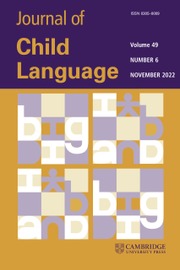Crossref Citations
This article has been cited by the following publications. This list is generated based on data provided by
Crossref.
Behrend, Douglas A.
1990.
Constraints and development: A reply to Nelson (1988).
Cognitive Development,
Vol. 5,
Issue. 3,
p.
313.
Soja, Nancy N.
Carey, Susan
and
Spelke, Elizabeth S.
1991.
Ontological categories guide young children's inductions of word meaning: Object terms and substance terms.
Cognition,
Vol. 38,
Issue. 2,
p.
179.
Naigles, Letitia
1991.
Learnability and Cognition: The Acquisition of Argument Structure.
Language and Speech,
Vol. 34,
Issue. 1,
p.
63.
Fisher, Cynthia
Gleitman, Henry
and
Gleitman, Lila R
1991.
On the semantic content of subcategorization frames.
Cognitive Psychology,
Vol. 23,
Issue. 3,
p.
331.
Soja, Nancy N.
1992.
Inferences about the meanings of nouns: The relationship between perception and syntax.
Cognitive Development,
Vol. 7,
Issue. 1,
p.
29.
Wynn, Karen
1992.
Children's acquisition of the number words and the counting system.
Cognitive Psychology,
Vol. 24,
Issue. 2,
p.
220.
Naigles, Letitia G.
Fowler, Anne
and
Helm, Atessa
1992.
Developmental shifts in the construction of verb meanings.
Cognitive Development,
Vol. 7,
Issue. 4,
p.
403.
Landau, Barbara
Smith, Linda B
and
Jones, Susan
1992.
Syntactic context and the shape bias in children's and adults' lexical learning.
Journal of Memory and Language,
Vol. 31,
Issue. 6,
p.
807.
Tomasello, Michael
and
Kruger, Ann Cale
1992.
Joint attention on actions: acquiring verbs in ostensive and non-ostensive contexts.
Journal of Child Language,
Vol. 19,
Issue. 2,
p.
311.
Naigles, Letitia G.
and
Kako, Edward T.
1993.
First Contact in Verb Acquisition: Defining a Role for Syntax.
Child Development,
Vol. 64,
Issue. 6,
p.
1665.
Tomasello, Michael
and
Olguin, Raquel
1993.
Twenty-three-month-old children have a grammatical category of noun.
Cognitive Development,
Vol. 8,
Issue. 4,
p.
451.
Ingham, Richard
1993.
Input and Learnability: Direct-Object Omissibility in English.
Language Acquisition,
Vol. 3,
Issue. 2,
p.
95.
Olguin, Raquel
and
Tomasello, Michael
1993.
Twenty-five-month-old children do not have a grammatical category of verb.
Cognitive Development,
Vol. 8,
Issue. 3,
p.
245.
Watkins, Ruth V.
Rice, Mabel L.
and
Moltz, Candace C.
1993.
Verb use by language-impaired and normally developing children.
First Language,
Vol. 13,
Issue. 37,
p.
133.
Forbes, James N.
and
Farrar, M. Jeffrey
1993.
Children's initial assumptions about the meaning of novel motion verbs: Biased and conservative?.
Cognitive Development,
Vol. 8,
Issue. 3,
p.
273.
Bloom, Paul
1994.
Possible names: The role of syntax-semantics mappings in the acquisition of nominals.
Lingua,
Vol. 92,
Issue. ,
p.
297.
Waxman, Sandra R.
1994.
The development of an appreciation of specific linkages between linguistic and conceptual organization.
Lingua,
Vol. 92,
Issue. ,
p.
229.
van der Lely, Heather K.J.
1994.
Canonical linking rules: forward versus reverse linking in normally developing and specifically language-impaired children.
Cognition,
Vol. 51,
Issue. 1,
p.
29.
1994.
REFERENCES.
Monographs of the Society for Research in Child Development,
Vol. 59,
Issue. 5,
p.
163.
Grimshaw, Jane
1994.
Lexical reconciliation.
Lingua,
Vol. 92,
Issue. ,
p.
411.

